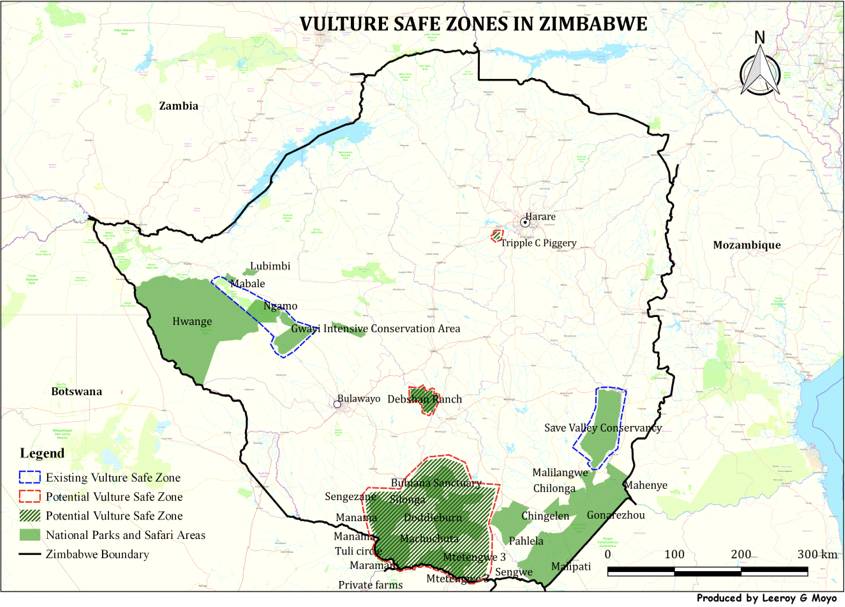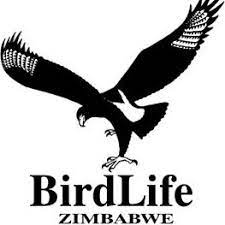CONSERVATION – PREVENTING EXTINCTION PROGRAMME
Vultures
Vultures are a distinctive, iconic and charismatic component of much of the African landscape, providing critical ecological and ecosystem services, stemming from the birds’ unique way of life. They are ‘obligate vertebrate scavengers’ and most efficient at cleaning up animal carcasses as they feed primarily on carrion. To succeed in this role, vultures can resist bacterial toxins in rotting flesh that would kill other organisms.
However, seven of the nine vulture species in Southern Africa are considered to be threatened, with others on the verge of extinction. In Zimbabwe, five vulture species, namely White-backed (Gyps africanus), White-headed (Trigonoceps occipitalis), Hooded (Necrosyrtes monachus) are Critically Endangered, with the Lappet-faced (Torgos tracheliotos) listed as Endangered and the Cape Vulture (Gyps coprotheres) considered Vulnerable, according to the IUCN Red List. In addition, all vulture species are considered Specially Protected Species and protected under the 6th Schedule of the Zimbabwe Parks and Wildlife Act (Chapter 20: 14).
The drastic decline of this avian family over the last 30 years is due to specific threats such as poisoning (intentional – reprisal by poachers to avoid detection and unintentional – feeding on poison-laced carcass meant to kill livestock predators) and trade in vulture parts for belief-based use, inappropriate use of agricultural pesticides, collision with energy infrastructure and powerlines, habitat loss and conversion of natural habitat to agricultural lands, persecution and disturbance at breeding sites.
Ecological consequences of vulture decline include changes in the community composition of scavengers at carcasses and an increased potential for disease transmission between mammalian scavengers at carcasses. For example, a recent study carried out in Kenya showed that, in the absence of vultures, carcass decomposition time nearly tripled, both the number of scavenging mammals and the time they spent at carcasses increased threefold, while contact rates between mammals increased nearly threefold, suggesting that disease transmission at carcasses will increase as vultures decline.
In realising the threats, BirdLife Zimbabwe, through the Zimbabwe Vulture Action Plan, is deploying measures to reduce the threats to vultures in Zimbabwe through the deployment of anti-poisoning measures, the establishment of Vulture Safe Zones (VSZs) with the inclusion of communities forming Vulture Support Groups. There are continued surveys and monitoring of the vultures and their nests across the country.
Project Name: Establishing a Vulture Safe Zone in the Gwayi Conservancy, Zimbabwe
Since the initial work by BirdLife Zimbabwe in the Gwayi Environmental Conservation Area in 2020, significant progress has been made. During the project implementation, BirdLife Zimbabwe has worked with Gwayi ECA in refining and adopting the Vulture Safe Zone Criteria and branding the area as the first Vulture Safe Zone in Zimbabwe. This effort has been made possible by the continued support and commitment of the landowners and communities to establish themselves as a Vulture Safe Zone.
 BirdLife Zimbabwe team working on Vulture conservation
BirdLife Zimbabwe team working on Vulture conservation

The Kavango-Zambezi Transfrontier Conservation Area’s (KAZA TFCA) expanse of 520 000 km2 lies in the Kavango and Zambezi River basins where Angola, Botswana, Namibia, Zambia and Zimbabwe converge, encompassing sixteen National Parks. In these areas, local communities are getting into conflict with species such as elephants and hippos, which results in the death of the animals through the use of poison, leading to the death of various scavenging species such as vultures through unintentional and international poisoning. Through transboundary collaborations, the solution focused on improved vulture conservation through the active participation of local communities in and around the three protected areas of the KAZA TFCA area while increasing awareness and capacity building on vulture conservation. These enabled the formation of Vulture Support groups mandated to champion vulture conservation in their respective areas.
Illegal Wildlife Trade/Belief-based Use
BLZ continues to work with traditional healers, various traditional associations and councils and private organisations to influence change in attitude, knowledge, and perception, as well as find sustainable alternatives to vultures and their parts. These measures have proved to be effective in encouraging healthy populations of vultures. Capacitating key stakeholders such as land managers and owners, community members to conserve vultures and ultimately biodiversity.
Project Name: Addressing Belief-based Use of Vulture Parts in Zimbabwe – Informing Regional Approaches
Location: Harare and Bulawayo
Project Name: Saving Africa’s Vultures: Combating Illegal Trade in Vultures for belief-based use
Location: Harare and Bulawayo
Project Name: Saving African Vultures: Scaling up Action against Belief base use of Vultures
Location: Harare, Bulawayo, Gokwe, Masvingo and Mutare
Biopama Project
Biodiversity and Protected Areas Management (BIOPAMA)
Project Name: Building multi-sectorial Capacity to Tackle Illegal Wildlife Poisoning: Poaching and Conflict in the World’s Largest Transfrontier Conservation Area (KAZA TFCA)
Funders: International Union for Conservation for Nature (IUCN)
Implementer: BirdLife Zimbabwe, BirdLife Botswana, Birdwatch Zambia, BirdLife International
Location: KAZA TFCA
Project period: January 2021 – September 2023
